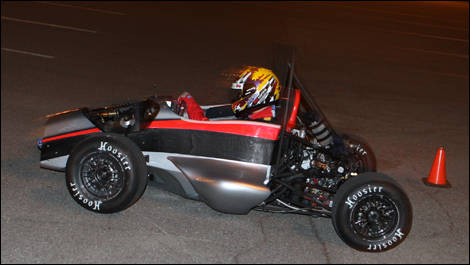Students are always looking to party, you say? Well, for some, the party will just have to wait because for now, they have a race car to build. A race car? That's right! A team of 12 students in mechanical engineering from Montreal's École de technologie supérieure (ETS) is dedicating nights and weekends not to go out but to work in their small work shop.
Their goal was to build within a year a single-seat race car to compete against more than 100 teams from all over the world at a competition to be held on the Michigan International Speedway, less than one week from now. The result is an open-wheel car powered by a 450-cc single-cylinder engine. It sprints form 0 to 100 kph in about 3 seconds -- faster than a Ferrari Enzo!
As for handling, their machine can reach 1.5 Gs of lateral force in corners, which is 50-percent higher than the famous Italian. In order to achieve these results, the students spent countless hours working on the machine in addition to their class hours.
Last fall, our colleague Bertrand Godin had the opportunity to test-drive the 2007 model (you can see the video here - http://www.auto123.com/fr/multimedia/videos/503696). Following this tryout, Auto123.com decided to take part in the development of the new 2008 model. I personally got involved with the team of future engineers in order to give you the ins and outs of building a race car for the Formula SAE series.
We made multiple visits to the work shop so as to get a close look at the development process. Believe me, no shortcuts were taken and no compromises were made. Every single part is carefully analyzed and tested before finding its way into the car. Plans are made using high-tech software and computers and then virtual simulations are generated to make sure each component will hold up.
The team went to considerable lengths to make their machine as lightweight as possible without sacrificing performance and reliability. In laboratory, they meticulously studied all types of molecules that make up carbon fiber, assessing strengths and weaknesses. These analyses allowed them to maximize the use of carbon fiber for the chassis. Therefore, the car is not only great-looking but remarkably rigid and lightweight.
 |
Their goal was to build within a year a single-seat race car to compete against more than 100 teams from all over the world at a competition to be held on the Michigan International Speedway, less than one week from now. The result is an open-wheel car powered by a 450-cc single-cylinder engine. It sprints form 0 to 100 kph in about 3 seconds -- faster than a Ferrari Enzo!
As for handling, their machine can reach 1.5 Gs of lateral force in corners, which is 50-percent higher than the famous Italian. In order to achieve these results, the students spent countless hours working on the machine in addition to their class hours.
Last fall, our colleague Bertrand Godin had the opportunity to test-drive the 2007 model (you can see the video here - http://www.auto123.com/fr/multimedia/videos/503696). Following this tryout, Auto123.com decided to take part in the development of the new 2008 model. I personally got involved with the team of future engineers in order to give you the ins and outs of building a race car for the Formula SAE series.
We made multiple visits to the work shop so as to get a close look at the development process. Believe me, no shortcuts were taken and no compromises were made. Every single part is carefully analyzed and tested before finding its way into the car. Plans are made using high-tech software and computers and then virtual simulations are generated to make sure each component will hold up.
The team went to considerable lengths to make their machine as lightweight as possible without sacrificing performance and reliability. In laboratory, they meticulously studied all types of molecules that make up carbon fiber, assessing strengths and weaknesses. These analyses allowed them to maximize the use of carbon fiber for the chassis. Therefore, the car is not only great-looking but remarkably rigid and lightweight.
 |


